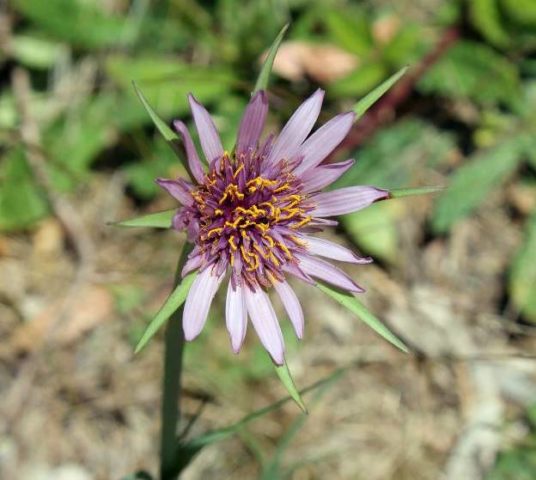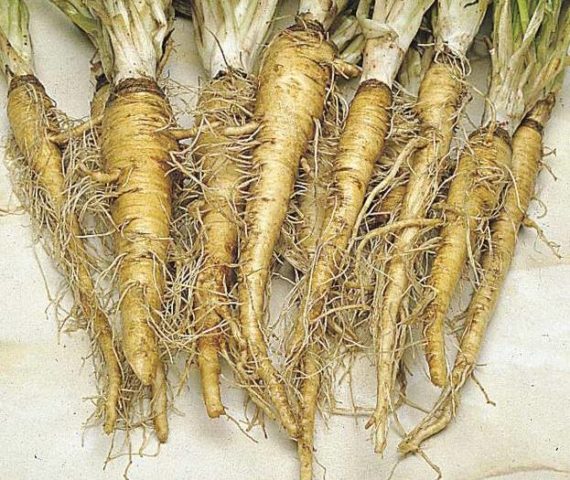Content
The common goat is used as a medicinal, vegetable, fodder and ornamental plant. The leaves of the culture are similar to those of oats, which is why it is popularly called oat root.

In cooking, the raw materials of this plant are added to dietary dishes, quite often you can find in the fields
Botanical description of the species
Goatbeard is a herbaceous, biennial plant. It belongs to the Astrov family. The stems contain milky juice, which is used in folk medicine. In height goatbeard reaches 1-2 m. Flowers are purple, collected in baskets.

In the first year of flowering, the leaves of the goatbeard grow in the form of a rosette.
The plant blooms in September and ripens in August. The taste of the flower is sweet. Grows in Siberia, Mediterranean countries and North Africa.
The fruit of the goatbeard is yellow, smooth, cylindrical in shape. It is covered with a dense skin, which, when broken, extracts juice.
Application in landscape design
The oat root has beautiful and bright flowers. For this reason, they are often used to decorate areas of houses. The plant should be placed in places where there is a lot of sun, so that it is not in the shade.
Often a purple culture is planted along paths, partitions, between groups of other flowers. The oat root visually divides the zones on the site.

A garden full of these flowers looks bright and rich
Landing rules
Goatbeard is planted in late April, early May, July or late October. It is recommended to choose a well-lit, moist and soft soil for planting. In clay terrain, the plant will grow tough and unfit for food. The earth should not contain acids, alkalis. This is harmful to the plant.
Planting holes are prepared in advance, at the beginning of autumn: potassium sulfate and wood ash are added to the ground. Also, vegetables and berries can be used as fertilizer. This increases the yield. It is recommended to recharge the soil in July.
The preparation of the land does not end there. In the spring, urea is poured into the beds. Oat root loves cold weather. It begins to grow at temperatures between 2 and 6 degrees.
Before planting, goat seeds are soaked for 14 hours in a special solution that stimulates growth.
It is necessary to plant the seeds of the long-leaved goatbeard according to the scheme: the distance between the holes should be about 30 cm, and between the rows 14 cm. After planting the plant, all the beds are covered with foil and left for 2 weeks. After that, it is removed and the next stage of sowing is awaited, which begins in July. By this time, the plant is saturated with moisture and gets stronger.
Growing features
After two weeks after planting, weeding begins. To avoid this, you can add mustard seeds to the soil, for example. They emerge on the fourth day after planting and divide the rows. It also gives the plant additional vitamins.
After 2 weeks, the leaves of the goatbeard are separated from each other and the soil is weeded. It is recommended to repeat weeding several times according to the growth of the rhizome.

In dry periods, the roots especially need additional moisture. Therefore, at this time, the goat beetle should be watered rarely, but abundantly.
Cooking applications
The wide-leafed goatbeard is not only healthy, but also tasty. It contains several valuable substances:
- A, groups B, C, PP;
- proteins, fats;
- phosphorus, iron, potassium.
Most often, the plant is cooked along with vegetables, seafood, cheese. As a preparation, the porous root is grated and added to horseradish.
It is popular to harvest the roots of the goatbeard immediately after harvesting. At the same time, it should be collected in mid or late November. After harvesting, the plant is soaked in cold water with salt and citric acid. This will remove the bitterness from the roots.
Leaves, roots, stems of the plant can be used for food. They are boiled, steamed, fried. You can often find the leafy part of the goatbeard in salads. Before cutting the leaves, it is necessary to squeeze the plant out of the milky juice.
Sometimes the porous root is used as a side dish instead of potatoes or cabbage. The active substances of the flower contain a large amount of inulin, which is beneficial for diabetics.
When cooked, the spiny goat is salty in taste. Oat root is good for weight loss, so it is added to diet salads.
There are many recipes for dishes with goat bark beetle. For a casserole from the roots, you will need the following ingredients:
- oat roots 500 g;
- one onion;
- 4 eggs;
- salt;
- sunflower oil.
The main ingredient is boiled until cooked and put in a baking dish, previously greased with sunflower oil. Then add beaten eggs and an onion to the roots. In an oven preheated to 180 degrees, remove the form with the ingredients. The dish is cooked for 20 minutes.
You can make a drink to keep the body toned. Of the ingredients, only goatbeard is required. The dried roots of the plant are fried in a dry pan. After they are crushed in a blender and poured with hot water. The drink tastes better if you add cream.
Conclusion
Goatbeard is a rich source of sugar, proteins, vitamins. The plant attracts the eye with bright colors, so it is often used to decorate areas of houses and summer cottages. The culture is not picky about weather conditions, loves the cold. The main thing when growing oat root is to follow the planting rules.








